An old axiom reminds us that “Goldfish will grow to the size of the bowl.” In the 1950s, America started building a very big bowl. Now it’s overflowing. What next?
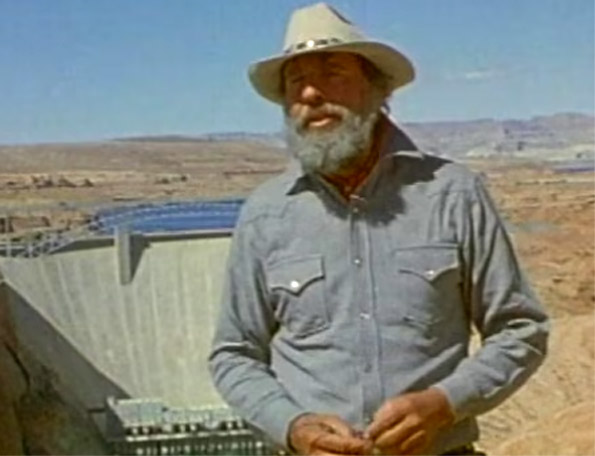
In March 1983, at the height of author Edward Abbey’s popularity, Cactus Ed and a group of environmentalists gathered at Glen Canyon Dam to mourn the 20th anniversary of the reservoir that formed behind the dam. Abbey had long ago denounced the construction of the dam, which flooded one of the most beautiful canyon systems in the world. But a decade before the dam was completed, the decision to build the dam had received the tentative approval of David Brower and the Sierra Club.
For years Brower had opposed the Bureau of Reclamation’s first site for a high dam at Echo Park on the Green River. Previously, the Sierra Club had mostly been an outdoor hiking club and rarely turned political. But in the postwar 1950s, with plans by BuRec to build a series of dams on the Green and Colorado Rivers, Brower used the Club’s influence to stop at least some of the dam building. And when the Bureau dropped its Echo Park dam, and proposed a compromise, Brower and the Sierra Club accepted the alternative. Later, Brower floated Glen Canyon for the first time; he had never seen the BuRec option that Brower accepted. It’s been said that after that trip, Brower seriously contemplated suicide. It haunted him for the rest of his life.
(For more on the beginnings of dam building on the Colorado River, check out these two stories. Gene Stevenson’s, “E.C. LaRue & the Colorado River of “Menace & Destruction,” & “America’s Insane Post-war Plans for the Colorado River.” by Jim Stiles)
Later the Sierra Club would publish a stunning coffee table book about Glen Canyon by noted landscape photographer Eliot Porter. He called the book, “The Place No One Knew.” And he was right. Now, twenty years later, Abbey & Company came to the dam to protest. By now he was affiliated with the group Earth First! As Abbey spoke, Earth Firsters were gluing and taping together 200 feet of black visqueen, in the shape of a long plastic triangle. It was supposed to represent the “first crack” in Glen Canyon Dam. They rolled the plastic onto a steel pole, climbed over a security fence, made their way to the center of the dam and unfurled it.
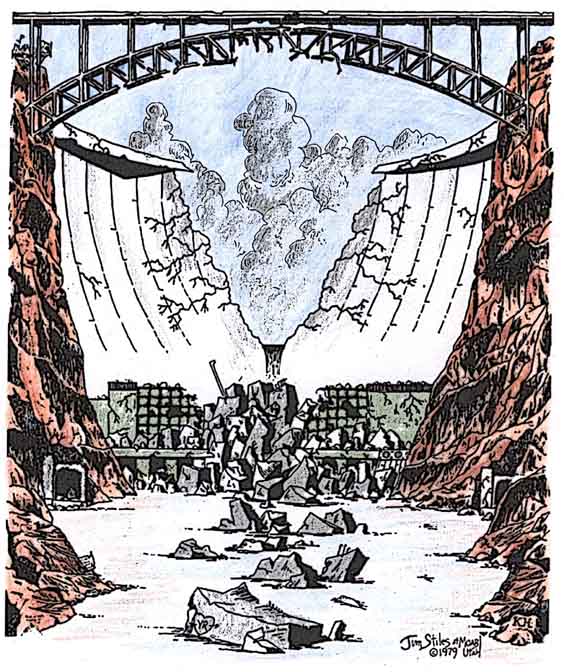
I had been actively involved in efforts to highlight the dam and the damage it caused; in fact, in September 1975, I had first gone to work on a rough pen and ink drawing of the dam, with a big hole in it. I was sitting on the septic tank cover at Abbey’s Arches National Monument trailer site, when the idea came to me.
A few months later, I learned that Abbey was living in Moab and I gave him the finished product. I met him during a poker game at The Ranch House, the impressive brick home just north of town. Meeting Abbey was not an event that I remotely thought might occur in my lifetime, and I was a basket case as my buddy Jim Conklin and I walked in the back door. But Abbey put me at ease, and graciously accepted my little sketch. For the next 15 years, Abbey and I maintained a steady friendship, though mostly long distance.
Just a few months after that meeting, Arches National Park hired me as its campground ranger. I lived in a tin trailer at the Devils Garden. If I had a nickel for every tourist who stopped and asked, “Was this Edward Abbey’s trailer,” I’d be a very wealthy man.
Seven years later, at the same time Abbey was offering his views on the dam, and as Earth Firsters were unfurling their symbolic plastic “crack,” I was just a few yards away. Incredibly, I was in Page for NPS law enforcement refresher training. Our classrooms were inside the dam itself, and during the days that followed Abbey’s event, the buzz was all about the “plastic crack.” One Coconino County deputy even confided that his department had dusted every square inch of the 200 foot long tarp for fingerprints.
For me, it was all good fun to play these dual roles and retelling the story to Abbey was one of the few times I made the usually taciturn Abbey belly-laugh. The unfurled, fingerprinted ‘crack’ also unfurrowed Cactus Ed’s usually furrowed brow.
In those days, my objection to the dam and Lake Powell was primarily the drowning of the canyon below the reservoir. And all of us, in those days, were driven by our own idealism and self-righteous indignation. But before he died on March 14, 1989, I came to understand Abbey a bit better, at least from my perspective. While Abbey railed against the dam and the insane growth of the American Southwest, he never thought his rants, or those of others, would make a hill of beans difference to the Future. In an interview with documentary filmmaker Eric Temple a year later, Abbey conceded that his real purpose as writer was “to entertain,” though he hoped his words might “make people think…if that’s possible.”

His books, both fiction and non-fiction, served more like a pressure relief valve for Abbey. It was surely how he blew off steam. But even then, Ed worried about being labeled “a terrorist.” He went out of his way to separate his war against machines with attacks on humans, no matter how misguided he thought they were. It worried him.
Just a few years before he died, he invited me to attend an “Earth First! Round River Rendezvous.” The gathering occurred at a remote North Rim view point at the far western edge of the Grand Canyon, and outside the park boundary. He was reluctant to attend, and as his friend Jack Loeffler noted in his book, “Travels with Ed,” Abbey hated to travel alone (A revelation that surprised me). I begged off and he showed up for the Rendezvous alone, but the next time I saw Abbey, months later, he said, “You were wise not to go.” He paused for a moment — the brow now heavily furrowed again — and he added, “Who are these people? There were all these damn hippies there! I think they take me too seriously.”
I said, “Ed…those are your most devoted followers…your beloved.” His brow furled even deeper. Three years later, Abbey was gone. At the May 24, 1989 memorial service for Abbey, held just outside the Arches boundary, EF! Founder Dave Foreman called Abbey “a trickster.” I knew exactly what Dave meant, though I’m not sure how many others did.
*****
Now, more than 30 years later, an historic drought and the possible effects of climate change have dramatically shrunk the flow of the Colorado River. The Powell Reservoir now contains a fraction of what it was meant to store. The situation at Lake Meade is even worse. If the reservoir level at Lake Powell falls much lower, and stays there, Lake Powell becomes a “dead pool.”
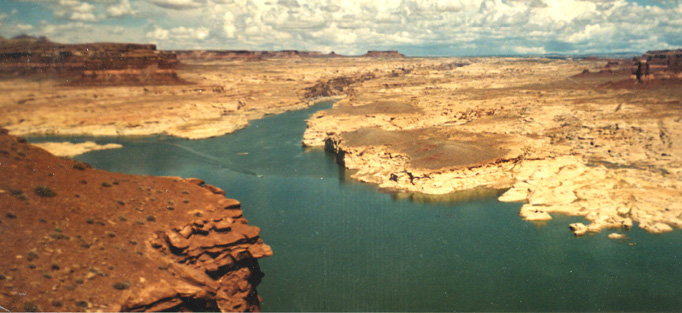
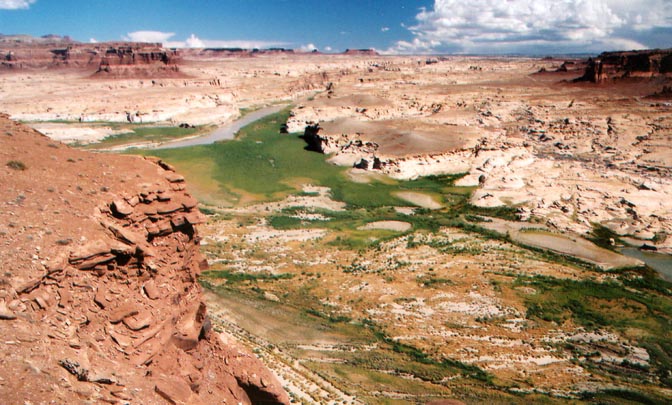
The reservoir releases water downstream via its massive penstocks. Once it falls below the intakes, there is no way to allow the water to move further downstream. The massive diversion tunnels which allowed the Colorado River to flow around the dam site during its construction, were plugged with concrete decades ago. The Bureau of Reclamation has even acknowledged that in that extreme situation, their only option would be the construction of new tunnels on each side of the dam to, in effect, pull the bathtub plug on Lake Powell.
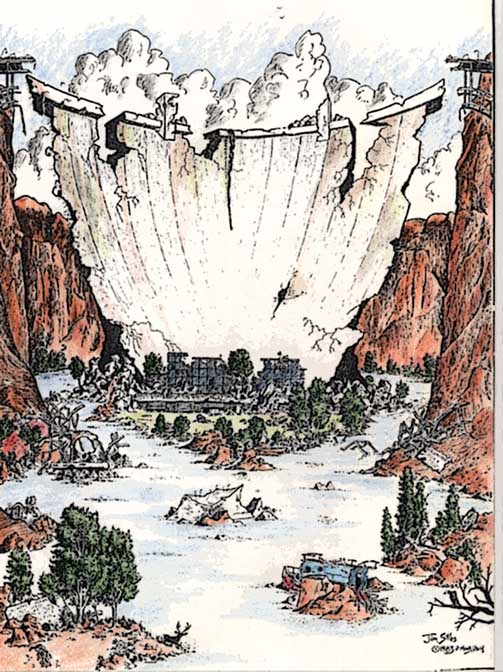
For many of us who have loathed Glen Canyon Dam for decades, it all sounds too good to be true. Surely Abbey would be dancing in his remote secret desert resting place. What’s not to celebrate? The truth is, it’s more complicated than we realize. Glen Canyon Dam did more than flood the canyon system under its waters. Sixty years ago, the dam created the core of the “New West” that we face today. It’s necessary to go back to the 1950s to understand how we created this nightmare that went much further than the concrete behemoth that buried Glen Canyon…
THE INEVITABILITY of GLEN CANYON DAM
The history of Glen Canyon Dam and plans to develop almost every mile of the Colorado and Green Rivers dates back more than a century. And again, to find the most comprehensive history of that period, check out Gene Stevenson’s Zephyr story, and mine about post-war plans for massive developments.
But to summarize, even before the end of World War II, but with victory in sight, the Bureau of Reclamation was looking ahead. In 1944 LIFE magazine published an article called, “THE COLORADO RIVER: A Wild & Beautiful River is Put to Work for Man.” While the story was full of spectacular images of the river and the course it took to the sea, and though it noted the incredible beauty of the many and varied canyons, the emphasis was on taming that wild river and making it, “the servant of man.”
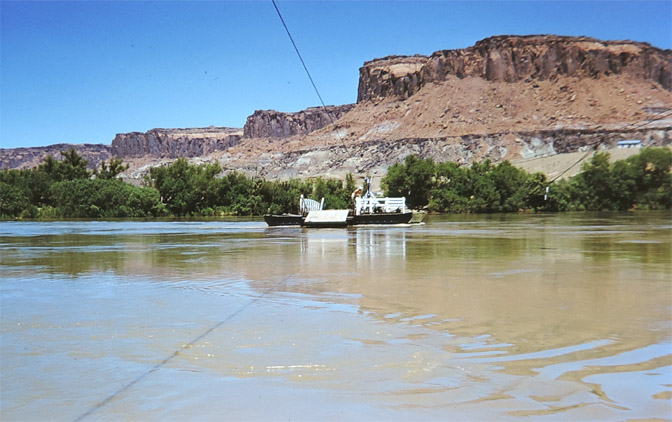
Americans, in general, thought there was nothing this country couldn’t accomplish. War production had proved it. In 1940, the United States Army was only the 14th largest in the world. In four years, American production and innovation was extraordinary. Now, if only Americans could put that power to peaceful use, America’s future could shine as never before.
In 1950, the American Southwest was a vast, near empty landscape. For the more ambitious, it was a blank canvas that waited to be filled. When America conducted its 1950 census, it found that Phoenix was the largest of the Southwest cities at the time –– it had a population of 107,000. Down the road in Tucson, the little town could only muster 55,000 residents. And further west, just miles from Hoover Dam, Las Vegas, Nevada’s population was 24,624.
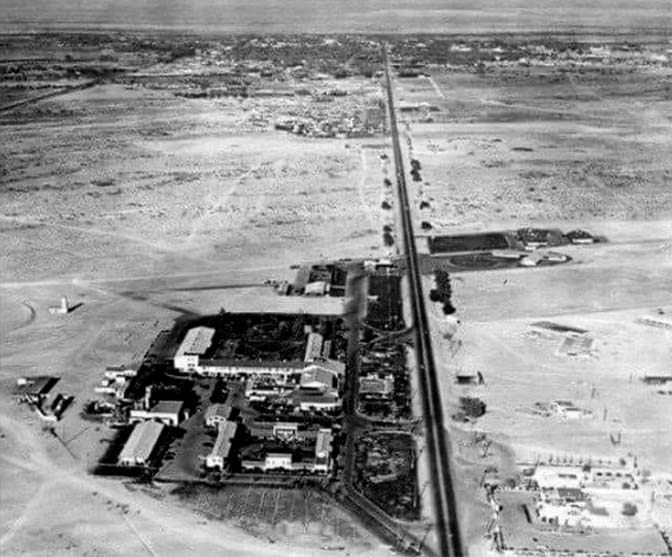
In the minds of most, the liquid burial of Glen Canyon was a small price to pay for the kind of growth most Americans seemed to want. When LIFE published its story on the Colorado River’s post-war dam plans, not one of the editors or writers lifted an eyebrow. In 1946, the National Park Service addressed the dam projects in a document called “A Survey of the Recreational Resources of the Colorado River;” the reader would be hard put to find much opposition from this sister agency of the Bureau of Recreation. There was one exception — BuRec’s plans for the Grand Canyon — you have to read if to believe it.
For the few who opposed the many dam proposals, it seemed as if “Resistance was Futile.” By 1956, authorization and funding for Glen Canyon Dam had been approved by the U.S. Congress and celebrated by President Eisenhower.
Those Americans who did resist were the tiny handful who knew what was about to be destroyed. River runners like Ken Sleight and Harry Aleson created their own grassroots organizations to resist what was inevitable. They were the Don Quixotes of their time, and even they recognized the futility in their efforts.
Beth and Ruben Nielsen had operated the ferry at Hite and devoted 15 years of their life to growing one of the most beautiful gardens in the desert. But even the Nielsens stoically accepted a buy-out from the government and moved on. For all of those who loathed the dam and the massive reservoir that would grow behind it, their sorrow was aimed solely at the loss of Glen Canyon and the free-flowing river they all loved.
But there was so much more to fear and loathe. Losing the Glen itself was just the beginning, and if you take Ed Abbey’s words to heart, “Glen Canyon isn’t gone; it’s just in liquid storage.’ And he was absolutely right. But the consequences of Glen Canyon Dam were, and are, far more profound and long lasting than the Dam itself.
IN THE SOUTHWEST, FISH WILL GROW TO THE SIZE OF THE BOWL.
If you didn’t live through the 1950s, there’s a commonly held but false impression that ‘nothing happened’ during the decade. With a grandfatherly president like Ike, and a generation of young World War II vets establishing new lives in the post-war era, Life seemed good. Vietnam was still ahead. The civil rights struggle was just beginning to awaken.
But the decade of the ‘50s initiated the groundwork, literally, for what was to come. As noted, America was ready for Boom times after a decade of the Great Depression and four years of world war. Growth was inevitable, but the explosive growth was stunning even to a five year old (me) living in the new “suburbs” of Louisville, Kentucky. While the BuRec was making plans to build even more dams, the recently designated Interstate Highway System would change America forever. Old two lane highways were slowly replaced by modern controlled access freeways. In a couple decades, it would be possible to drive coast-to-coast without ever seeing a stoplight.
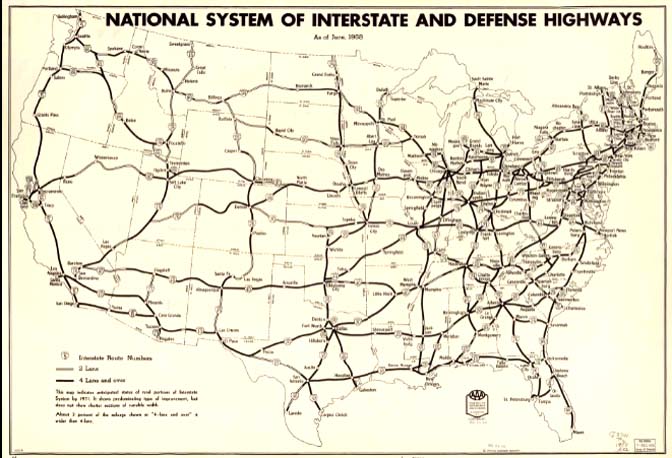
The young vets, with the GI Bill to help fund their college education, saw a massive move to the Suburbs. The word was new to the language lexicon. After centuries as farms and pastures, one green field after another, across America, vanished under the weight of new residential and commercial developments. Few noticed. A song called “Little Boxes” became a popular song in the late 50s, and while everyone saw the truth in its lyrics, most Americans shrugged — it was just another passage, from one era to the next.
Little boxes on the hillside,
Little boxes made of ticky tacky
Little boxes on the hillside,
Little boxes all the same.
There’s a pink one and a green one
And a blue one and a yellow one
And they’re all made out of ticky tacky
And they all look just the same.
(To hear it sung, by its composer, Malvina Reynolds, click here.)
America was transforming its infrastructure. Entire sections of cities were razed. The historic value of these old buildings was zero. It was necessary to destroy the old, to make way for the new.
(I remember one evening when I was about nine, my dad took us downtown, to Main Street in Louisville to see a particular building torn down. My parents belonged to a bridge club and one of the other couples, Doris and Charlie Wheeler, had purchased the bricks that could be salvaged to build a new home in an upscale neighborhood adjacent to Seneca Park. It was probably as close as anyone came in those days to recycling. But entire sections of Louisville looked like postwar Europe. It was as if we’d bombed ourselves.)
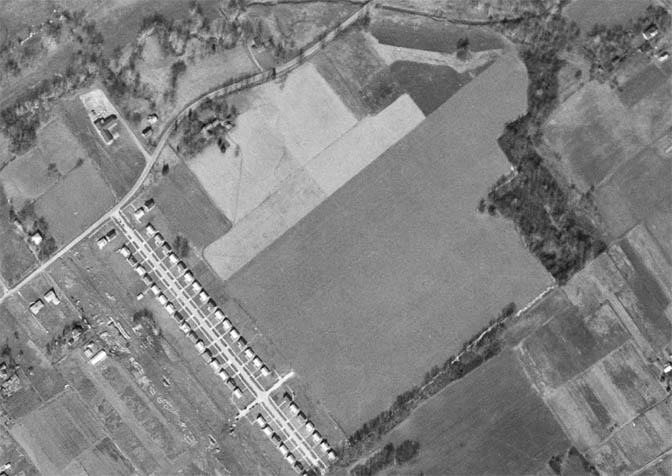
The story was the same in every corner of the country. Old diners were replaced with fast food chains. It introduced an architecture heretofore unknown. In one decade, it was possible to stand in any part of my old hometown and, if they’d somehow been away, the scene would have been unrecognizable. In New York City, history vanished in a cloud of dust and debris. Even the magnificent Penn Station was demolished and was replaced by a more ‘functional,’ multi-purpose Madison Square Garden events center. The key to architectural success in the 1950s was its functionality and its blandness. If bland was the goal, the results were stunningly successful.
*****
But reimagining the cities was just the beginning. Developers and politicians and the general public were hungry for more, and the American Southwest was ripe for the picking. Now, in order for the Southwest to grow far beyond anything that could be called “sustainable,” proponents needed two rare commodities for the arid deserts — water and power. Projects like Glen Canyon Dam and the Powell Reservoir were planned and built with that goal in mind.
Damn sustainability…full speed AHEAD.
The site for the Glen Canyon Dam was, like much of the Four Corners region, one of the most remote parts of the continental United States. New roads needed to be built, a new bridge…even a new town. Soon after funding for the dam was authorized, bids were let for the dam’s construction. The project would hire thousands of workers. Some of the statistics associated with the dam’s construction are dizzying. Whether you liked the dam or hated it, the idea that this kind of project could be created, implemented and completed in less than a decade, was mind boggling. Consider these bullet points…
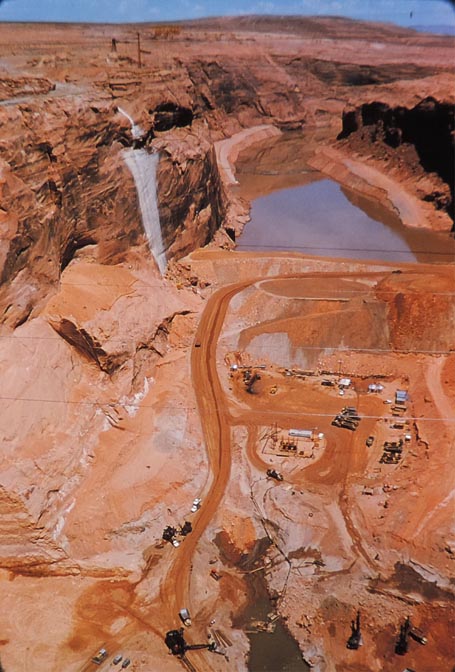
* Before construction of the dam could begin in earnest, a bridge was required to link the two sides of the canyon. BuRec gave the contract to Peter Kiewit Sons and the Judson Pacific Murphy Co. for $4 million. Construction began in late 1956, and was completed in less than a year, on August 11, 1957
* With the bridge in place, BuRec awarded the contract for the construction of the dam to Merritt-Chapman & Scott Corporation. Their bid of $107,955,552 was $30 million less than BuRec’s estimate.
* Before work on the dam itself could start, it was necessary to divert the Colorado River around the construction site. Two massive 41 foot tall diversion tunnels were blasted out, on both sides of the dam. Eventually 187,000 cubic yards of Navajo sandstone was removed from within the canyon walls; that material was then used to build the coffer dam just upstream from the site. This finally diverted the Colorado River and work on the dam began in earnest.
* Massive amounts of concrete aggregate were necessary and a concrete plant was constructed near the dam site. It could produce 1450 tons of concrete per hour. As the dam rose above its foundations, concrete was being poured into the dam at the rate of 8000 cubic yards a day.
* By early 1963, the dam had risen to such a height that the diversion gates were permanently sealed and the reservoir began to rise. After January 20, 1963, the Colorado river became Lake Powell.
* It took 17 years, from 1963 to the spring of 1980, for Lake Powell to reach pool level (3700 feet above sea level) and three years later, an unexpected rapid Spring runoff in the Rocky Mountains almost caused the reservoir to breach the dam.
Since then, the reservoir has slowly shrunk. An insatiable demand for water, coupled with an historic drought has drawn the lake down to 25% of its original capacity of 27 million acre feet (an ‘acre foot’ is an acre of water at a depth of one foot,).
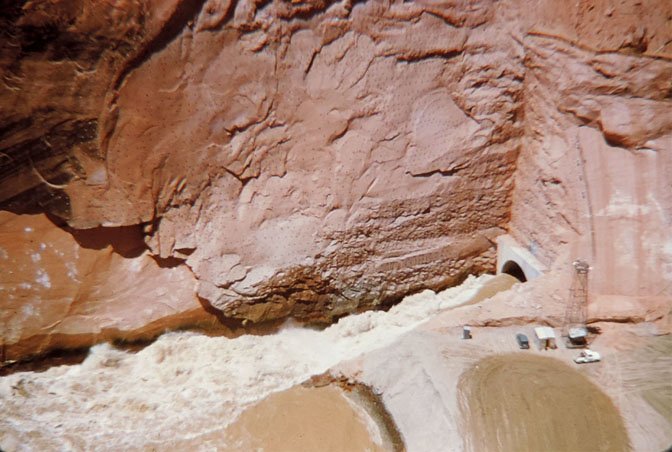
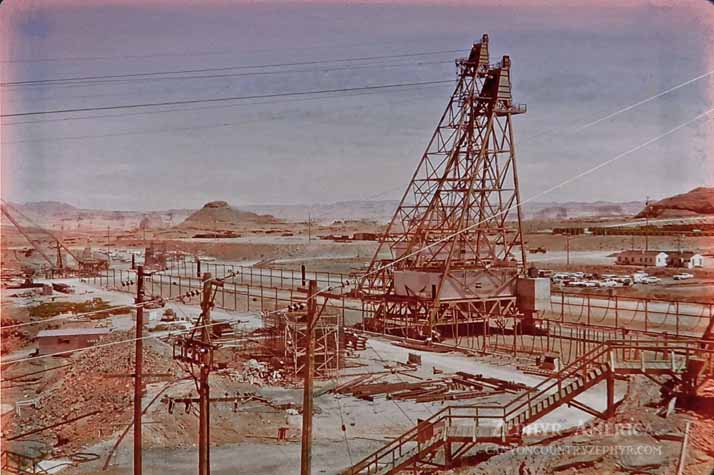
But in 1963, with plentiful water and an entire region of the country to develop and “improve.” The once backwater desert southwest cities and towns faced unprecedented change. In decades the Southwest would become the fastest growing region in the United States, But it needed more water than ever. And it needed something else…POWER.
Producing electrical hydro-power was, in fact, BuRec’s other main goal for the dam. And its best selling point. If the cities of the Southwest were to grow at the rate that was hyped and hoped for, and even expected, new sources of power had to be created. Hoover Dam had already proved to be a significant producer of electricity. Glen Canyon Dam would soon stand second. For supporters of the dam and the BuRec dam building agenda, Glen Canyon Dam was called “the cash register dam.” The dam also serves as “a primary peaking power plant and black start power source for the Southwest electrical grid.” In the beginning, the power plant had a total capacity of 1,320 megawatts from eight 165,000 kilowatt generators.
We have all seen the results.
By 2022, the Southwest’s population had exploded. Consider these 2022 numbers:
Phoenix: 4,584,000
Tucson: 1,003,000
Las Vegas: 2,272,000
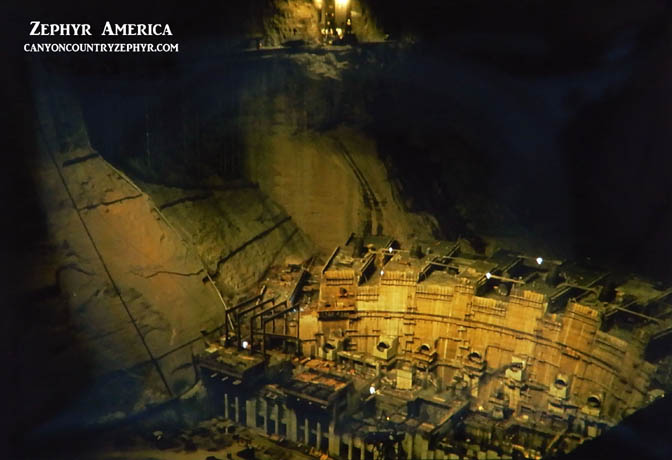
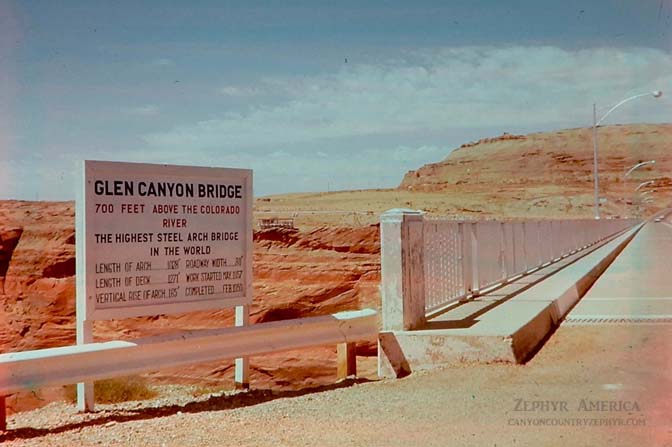
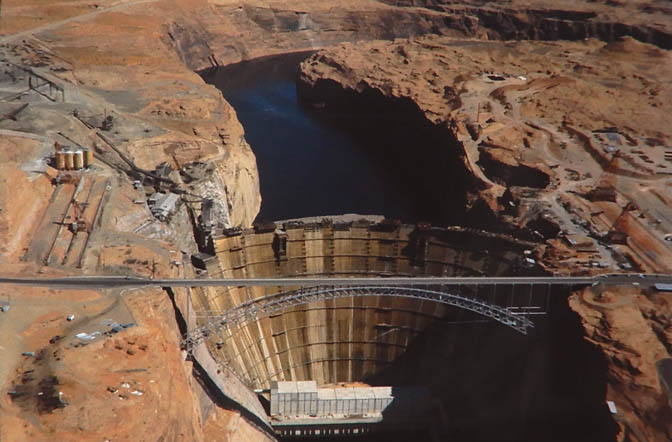
According to Wikipedia, which offers a fairly comprehensive history of the dam:
“Between 1980 and 2013, Glen Canyon Dam generated an average of 4,717 gigawatt hours (GWh) per year, enough for about 400,000 homes. The highest was 8,703 GWh in 1984, and the lowest was 3,299 GWh in 2005. Power generation is affected not only by the volume of water passing through the dam, but also the depth of water in the reservoir, as a higher water level means more pressure (head) on the turbines Hydropower generated at Glen Canyon serves about 5 million people in Arizona, Colorado, Nevada, New Mexico, Utah and Wyoming, and is sold to utilities in these states as 20-year contracts…. Drought conditions in the 21st century have reduced the amount of hydropower available from Glen Canyon Dam.”
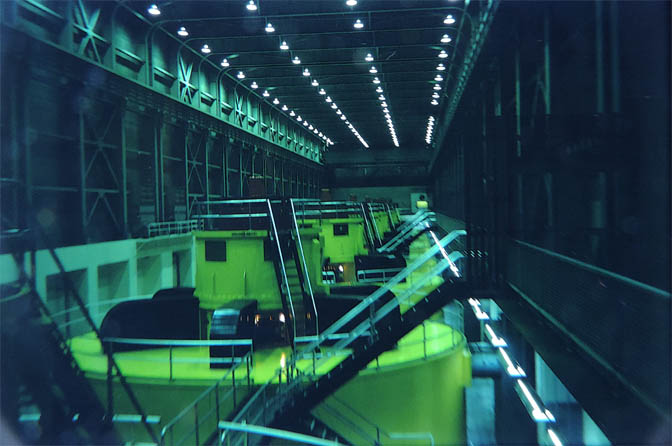
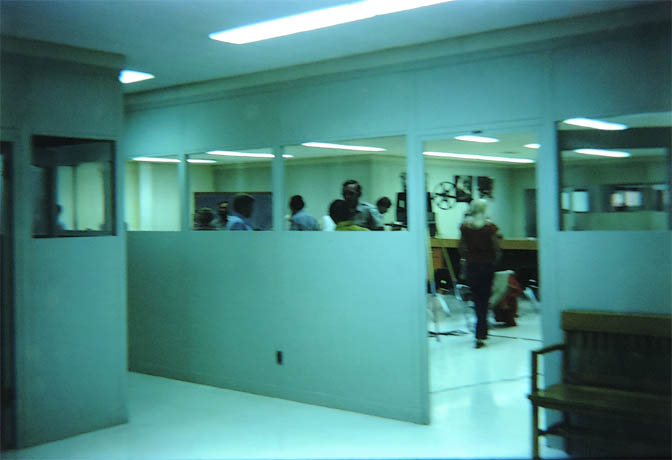
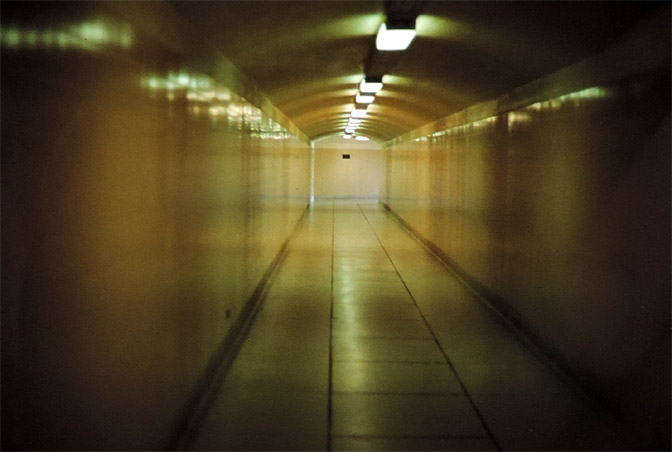
UNINTENDED CONSEQUENCES aka “WHO CARES?”
Virtually no one in government or the private sector saw a problem with this kind of growth. “Sustainability,” as a catchphrase to rally behind, didn’t exist. Even an administration as liberal as LBJ’s, with Interior Secretary Stewart Udall, a JFK pick in 1960, assured the country that with conservation efforts, a massive increase in power production, and the creation of an ample supply of water in reservoirs like Glen Canyon and Hoover, could meet future needs.
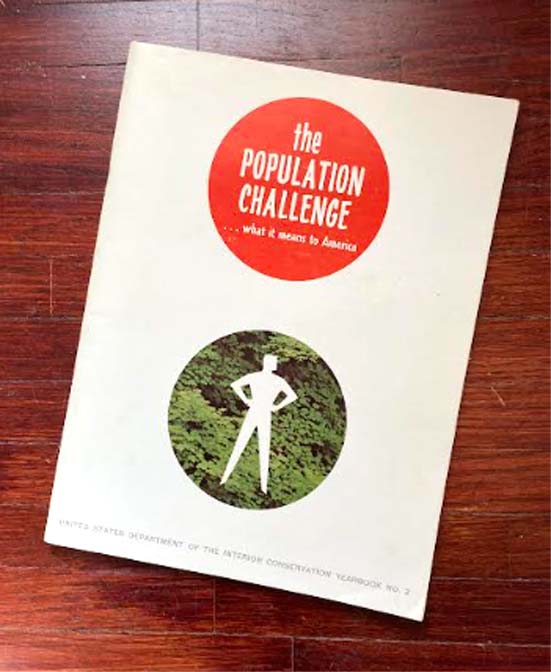
A 1965 publication, produced by the Department of the Interior, offered its own projections for future growth, including population, and resources to provide for an expanding population. It was called “The Population Challenge…What it Means to America,” and included a forward by Secretary Udall.
If anything, the government was predicting faster population growth and a higher rate of natural resources consumption than what real data from Year 2000 later revealed. The US Government expected the population to reach 362 million by 2000; in fact, the 2000 census showed 282 million. (As of now, the US population is in excess of 330 million. And yet its projection for world population was almost spot on. From a predicted 6 billion inhabitants, real numbers for 2000 showed a global population of 6.144 billion.
But the government dramatically underestimated the country’s gross domestic product. It had projected the GDP to reach $1,956 trillion by 2000. In fact, it surpassed $10.25 trillion in 2000. The result was the New West we find now. The fastest growing states in America can mostly be found in the country’s driest region.
And yet, as the DOI publication shows, there was a consensus among government and private enterprise interests alike,that the country could reach these goals and maintain a healthy natural environment, while securing a comfortable lifestyle for its citizens.
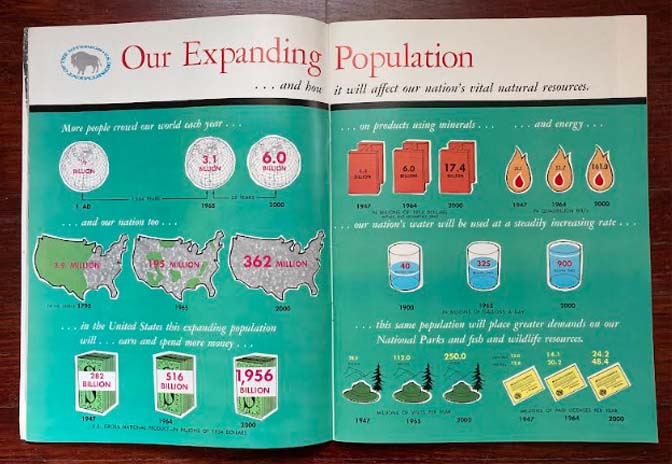
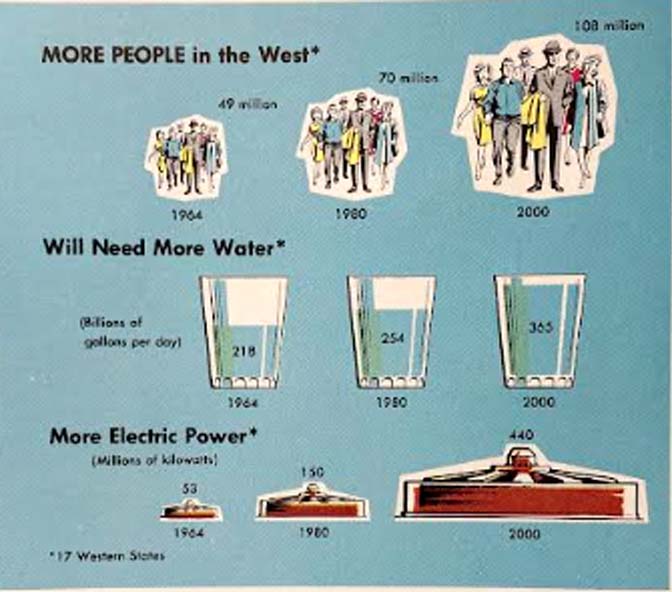
U.S. Census reports show the Western migration has been ongoing for more than 30 years, but it has been especially notable since the turnof the century. In 2011 I wrote a story called “Census 2010 & the Migration West.” The four fastest growing states, Nevada, Utah, Arizona, and Colorado, all depend on the Colorado River. Three of those states are the driest in the country. In that article I wrote:
“All of these Urban Migrants want to be a part of something that doesn’t exist anymore. It’s an interesting irony that almost all “New Westerners” rail against the “redneck” mentality that used to govern the rural west before we came along to save it. But at the same time, we long for the West the way it was 40 years ago, when the ‘rednecks’ were running the show.
“New Westerners come to live here as permanent tourists. They’ve come to be closer to the beauty they have admired for so long and rail against those who extract natural resources from it. But at the same time, they have no problem consuming those resources. They oppose oil/gas production but heat their new homes and power their hybrid SUVs. They condemn timber extraction but build new 4000 square foot homes in the desert and forests of the West. They oppose new dams and water pipelines but xeriscape their lawns and think they are good conservationists. And then they condemn the old timers for not being progressive enough.“As the West becomes less of what it was, what really made the difference?
“Us, en masse. Millions of us. We came here to save it and subsequently ruined it with our sheer numbers and our desire to bring our urban habits with us. I doubt you could get a mussel shell dish in Flag 40 years ago, but who’d be willing to trade a seafood dish for some real peace and quiet? In today’s rush to be part of a myth, I’m not sure anybody notices.”
AND THEN, REALITY HIT…..OR DID IT?
For years, I’ve fallen back on this quote from author Wendell Berry…
“…this is what is wrong with the conservation movement. It has a clear conscience….To the conservation movement, it is only production that causes environmental degradation; the consumption that supports the production is rarely acknowledged to be at fault. The ideal of the run-of-the-mill conservationist is to impose restraints upon production without limiting consumption or burdening the consciences of consumers.”
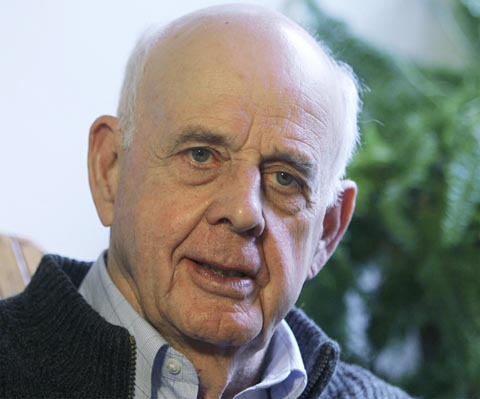
Mr. Berry always saw the future more clearlym and more fairly, than the rest of us. It really is the bottom line.
As the desert southwest exploded, communities, big and small, saw unprecedented growth that placed severe financial and environmental strains on them. Real estate prices, both commercial and residential, skyrocketed. Property taxes, rents, and the general cost of living, followed close behind. There were plenty of warnings that the Southwest was pushing far beyond its capacity to provide services and utilities to its burgeoning residents. But it didn’t matter; instead of trying to control growth, the conventional wisdom was to ‘mitigate’ its effects.
It became ‘THE WORD’ to address all the issues of an out-of-control economy and the society it catered to. Environmental impacts? We’ll mitigate those issues. Unaffordable housing? We’ll mitigate that as well. But now, ‘mitigation’ takes on an entirely new meaning. For the New West to survive…no…that’s not right. For the New West to continue to thrive and grow, it now faces a serious dilemma.
As noted and repeated, for the New West to survive, it must have plentiful and available sources of water and power. The Southwest was built on the back of fossil fuels and hydropower. Now all that is about to change.
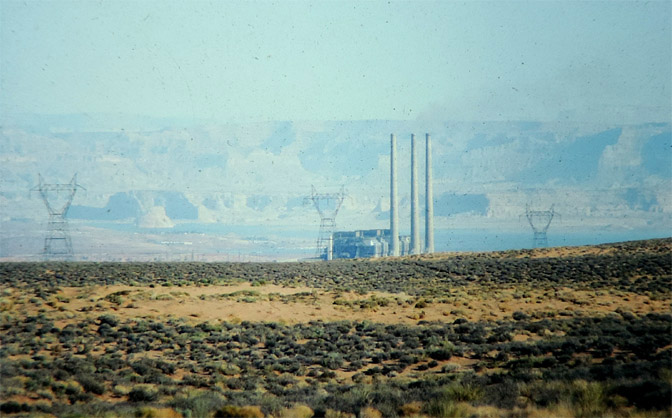
The use of coal for energy in the United States has plummeted in the last two decades. Many of the coal-fired power plants in the Southwest have shut down. The Navajo Generating Station shut down last year. The coal plants at Farmington and Shiprock have been, or are about to be, phased out. The economies of the Navajo and Hopi Nations have been devastated by the shutdowns. It’s another example of a false economy that briefly raised the standard of living in an economically distressed part of the country, but which now faces few options. In addition to the casino/tourism option, the solar industry is already making a pitch for more solar projects.
Ironically, while domestic use of coal has decreased substantially, coal production, as an export predominantly to China, India, and other “developing nations,” has increased. In 2022, 61% of China’s electricity was generated by coal. We are transferring our “carbon footprint,” more than we are reducing it.
Hydropower, especially the high dams on the Colorado River —Hoover and Glen Canyon — are now approaching the end of their productive lifetime. The builders of the dams knew their projects had a limited life span, they knew that sediment alone would render the dams useless within a century. It was a given. While it wasn’t a prime motive, it was recognized that Glen Canyon Dam would, or should, extend the life of Lake Mead by catching most of the sediment carried by the river.
Its proponents also knew that if the demand for water grew beyond the supply, and if that supply was threatened even more by an historic drought, or climate change, the Urban Southwest would face unprecedented challenges.
At Glen Canyon Dam, the generators could produce 1,320 megawatts, But now, with reservoir levels 100 feet below maximum pool, hydropower production has dropped to 800 megawatts
Hoover Dam’s future is just as bleak, if not bleaker.
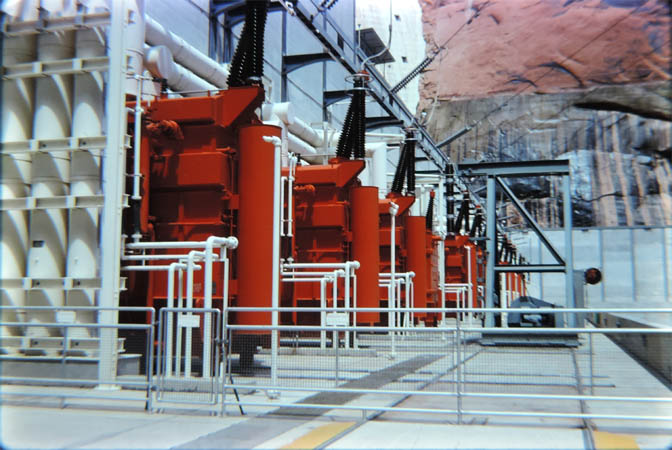
*****
Today the Baby Boom generation is on the cusp of fading into history, its performance is checkered at best. Gen X Americans, those citizens born in the mid-60s to late 80s — even they are approaching retirement age beginning in the next decade. It’s clear that with a couple more election cycles under their belts, the Millennials and Gen Zers, those under 40, and who today represent more than half of the country’s population, will assume responsibility for their own future. They will determine the hard choices that need to be made. They’re harder than they might realize.
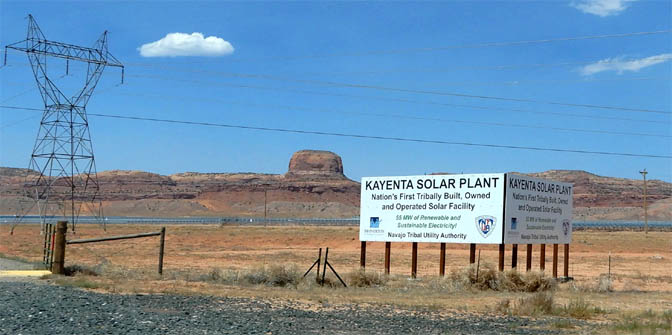
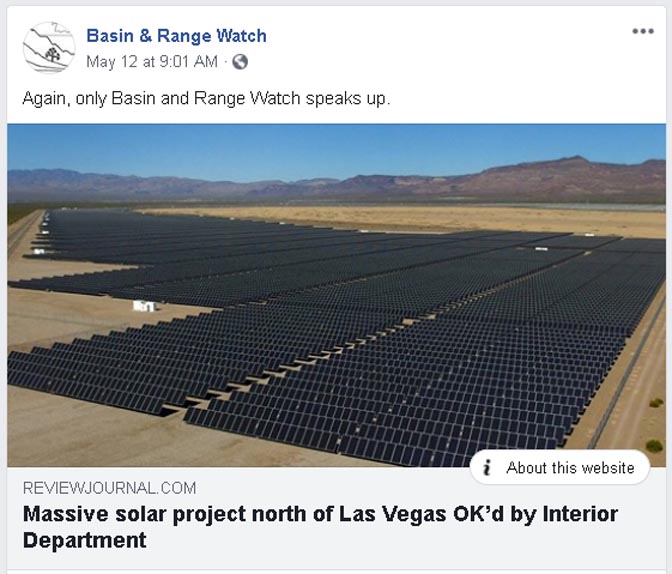
For those of you who embrace the Green New Deal, the massive program introduced to Congress four years ago, by Rep. Alexandria Ocasio-Cortez, The GND called for “transitioning to 100% renewable energy (no nukes or natural gas) by 2030″…or if you believe a 100% Renewal Future is imminent, consider these fats…
The GND proposal languished in Congress, and last year, Ocasio-Cortez and Senator Markey of Massachusetts. But parts of the GND have found their way to enactment via President Biden’s 2022 Inflation Reduction Act.
As today’s younger Americans look to the future and weigh their options, consider these numbers, from the fastest growing and driest states in the country…
* In Arizona, as of 2022, 99% of Arizona’s total electricity net generation was provided from six sources: natural gas (42%); nuclear power (29%); coal (12%); solar energy (10%); hydroelectric power (5%): and wind (1%).
* In Utah, 53% of its electricity comes from coal. Natural gas provides 26% of the state’s needs. Renewables account for just 16% of its total demands. Of that 16%, only 11% comes from wind power. Hydropower is considered a “renewable” energy source.
* And in Nevada, in 2022, natural gas provided 56% of the state’s energy needs. Renewables, mostly in the form of solar, geothermal, and hydroelectric sources, meet as much as 37% of Nevada’s electrical requirements.
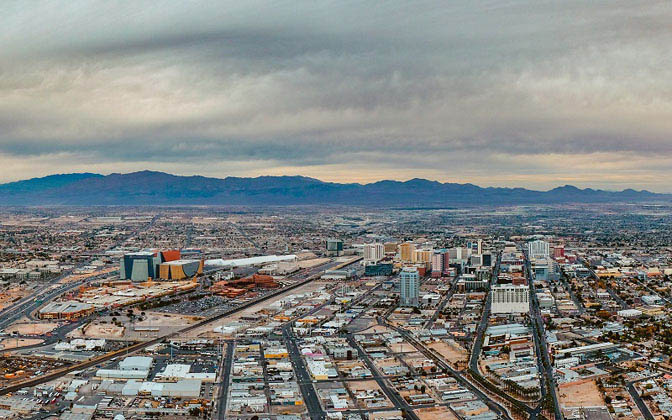
These numbers are changing rapidly. If readers are surprised at the high percentage of “renewables” in Nevada, they haven’t been to Nevada lately. I haven’t been back myself in almost three years, but I keep track of the expanding renewables economy, mostly via my friends at “Basin & Range Watch,” a small grassroots organization that has been a lonely but persistent voice in expressing its concerns regarding industrial grade solar and wind facilities.
But if current public opinion holds, especially among members of the Gen Z and Millennial generations, the race to renewables is unstoppable, but at what cost? Two thirds of all Millennials support the Green New Deal; Sixty-one percent of Gen Zers express similar support.
For the purposes of this story, I’m not here to argue IF renewable energy can be produced in sufficient numbers to end the use of fossil fuels. Let’s say it’s possible. But how will the transition to 100% renewables change the landscape of the American West? And at what cost?
GOING RENEWABLE…& THE CONSEQUENCES
The environmental impacts from renewables are just now beginning to be recognized and considered, though the vast majority of Americans are so ill-informed about the impacts from renewable energy that most fail to grasp their severity, or their scale. Ultimately, there’s no easy or clean way to transition from fossil fuels to renewables.
But if we plan to embrace renewables in the near future, what will be required to make that transition? And where are we now?
In 2022, the most recent year available, renewables account for about 13% of all energy consumed by the United States. The pie chart below shows the breakdown. But within that 13%, what counts as “renewable?” And where does it come from? Almost 20% comes from hydroelectric power — like Glen Canyon Dam — and I doubt I’ll find too many Zephyr readers who want more dams on America’s riverways. And “biomass,” which includes the consumption and conversion of biomass waste, biofuels, and wood to energy, represents 37% of all “renewables.”
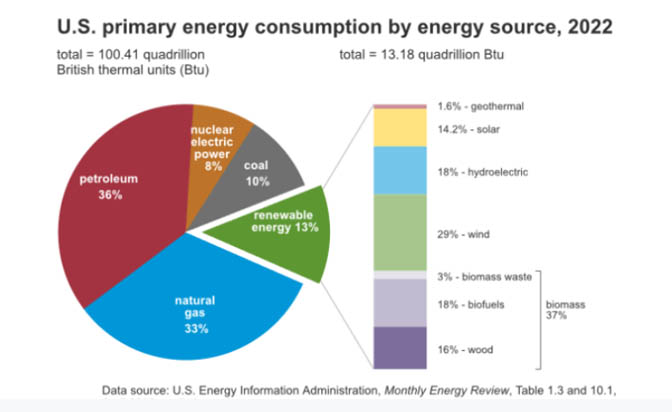
Consequently, of that “13% renewable energy,” less than half of that statistic is acceptable to Green New Deal supporters. And architects of the GND reject out-of-hand, natural gas and nuclear alternatives.
What would it take to fill that gap between what the country needs to be fossil-free and where we are now? According to the U.S. Geological Survey, “…as of January 2022, the U.S. Wind Turbine Database (USWTDB) contains more than 70,800 turbines. These turbines have all been constructed since 1980 in approximately 1,500 wind power projects spanning at least 44 states (plus Puerto Rico and Guam).”
Proponents of wind power estimate at least 1.25 million wind turbines, operating at maximum efficiency, would be required to replace the current domestic demand for energy. Of course the number is only meant to illustrate a point. Surely solar will play a role as well. But in both cases, it’s not just the construction of these facilities that are needed. Wind farms and solar projects are rarely near the sources of highest demand. The construction of new transmission networks and the evolution and implementation of massive batteries to store that energy are absolutely necessary.
What’s the lifetime of these industrial grade batteries? Where do we put the waste? Where do we get the minerals, rare earth and otherwise, to maintain and replace these renewables? If none of this deters supporters of a rapid transition to renewables, then expect a landscape across the country that bears little if any resemblance to the America we know now.
We all lament the loss of Glen Canyon. Imagine much of the continent transformed by the effects of a 100% renewable transformation? Or is transmogrification a better term?
Note the opening scenes of Ridley Scott’s “Blade Runner 2049.” The Mojave Desert may someday look like this…
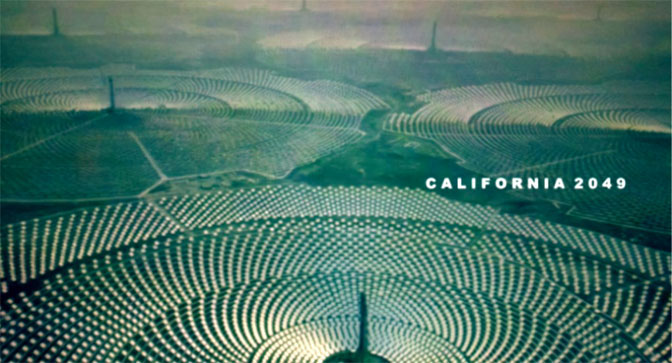
And yet, enthusiasm for renewables continues, with federal government subsidies, at a frenzied rate. A recent report noted that “Arizona ranks second in the nation in solar energy potential after Nevada, and ranks in the top five states in the nation for total solar-powered generating capacity.”
Clearly developers are depending on a solar grid from state border to border to accomplish these goals. And they’re not waiting for it to happen either. While Phoenix and other booming cities in Arizona are making minor moves to limit growth, it’s more a smoke screen than a genuine concern. Media reports from 2023 offered this:
“According to RL Brown Housing Reports, 22,222 new home permits were approved in the Phoenix Metro in 2022. In 2021, more than 31,000 permits were approved, and 29,000 in 2020…more than 82,000 new homes were approved and built in the Phoenix area in three years…”
In Phoenix, the average price of a new home is $592,099 dollars. It’s been the same old story, for time immemorial… FOLLOW THE MONEY.
BUT WHAT ABOUT THE WATER?
Even if future Americans somehow accept the consequences of a coast-to-coast renewable grid, with all its impacts and consequences, the desert Southwest still needs water. There may be a variety of options to create energy, but despite feeble and ultimately unworkable efforts to make desalination a viable route to usable water, water cannot be ‘made’ in the quantities needed for a booming population. For Phoenix and Las Vegas and all the other metropolitan areas of the new West to survive, they need the water. And they’ll get it, and agriculture in Arizona will die as a result.
Almost twenty years ago, I wrote my only book: “Brave New West: Morphing Moab at the Speed of Greed.” It sold out of its first printing, but never went to a second. The book stirred a few emotions, both in support of the book’s premise and adamantly opposed to it. I especially invoked the fury of public lands ranching haters when I made this observation…
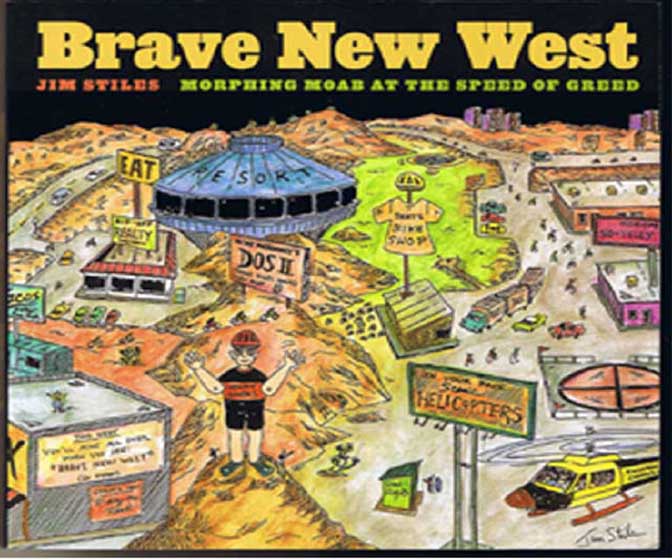
One morning a few summers ago, a friend and I were discussing the fires sweeping the West. The conversation turned to water and my friend, the owner of a recreation-based company, complained bitterly about the amount of water devoted to agriculture in Colorado.
“Did you know,” he asked bitterly, “that 80% of the water in Colorado is used for agriculture? Yet farming and ranching only constitute 14% of the economy?” (my numbers are estimates–I can’t recall the precise figure but that’s close)
A decade ago, I might have nodded sympathetically and joined the chorus of dissent. But instead I said, “So what?”
“So what?” he growled in disbelief. “What are you talking about? You think it’s GOOD that farmers use so much water?
“Well what would you prefer?” I answered. “Consider the agricultural lands in many of the valleys in Colorado. Would you rather see them save the water for human consumption and encourage 50,000 people to move into the area? If you shut down the farms, surely there will be plenty of water for massive urban expansion.“
‘”No,” he replied. “I don’t want that either.”
‘I shook my head. “Well, it’s going to be one or the other. As B. Traven once said, ‘This is the real world, muchacho, and we are all in it.’ Do you think they’ll just let the water flow slowly to the sea? This is America, pal. Somebody’s going to make money off that water.“
So this is a question about highest and best use of the land that all environmentalists need to answer. Imagine there is a 100 acre alfalfa field that requires 100,000 gallons of water a week to produce a healthy crop. But what if a condominium complex of 300 units could be built on that same 100 acres and the water use by all those new condo residents could be cut by as much as 75%. Would the new construction represent a “higher and better use of the land” because it used less water? It’s a question we all need to consider.
That was in 2006. I wonder how many farms have vanished since then?
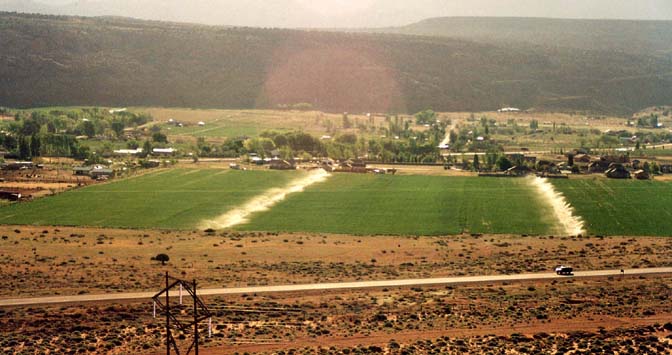
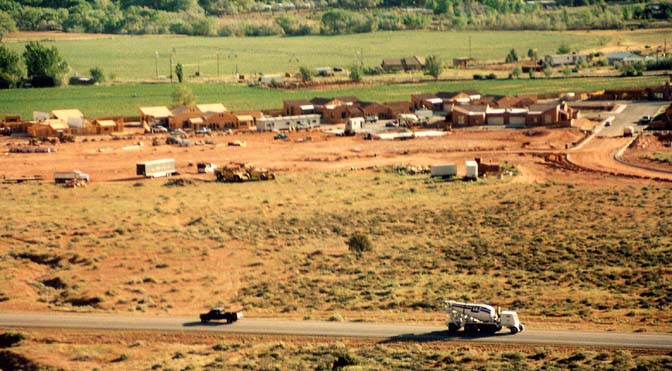
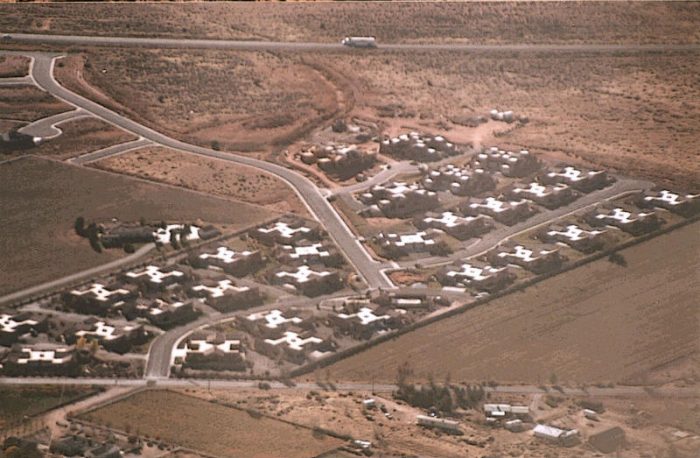
*****
Thirty five years ago in Moab, the New West was just beginning to sink its claws into my quiet little town, and that vast mostly empty expanse (except for trailers and blessed junk cars) of Spanish Valley. I was lamenting the coming changes over a burger at the Main Street Broiler with a couple kindred spirits. But our conversation was overheard by a relative newcomer; he was one of the early Mega-Millionaires to find Moab, but claimed to be ‘one of us.’ He wanted us to know he was as concerned as we were.
“I have a plan,” he said cryptically. “I can save Spanish Valley for sure.” We were curious. Even foolishly hopeful. What was his plan?
“One word,” he said. “Salsa.” We asked him to explain. He thought that if he could buy up much of the vacant Spanish Valley land, he could create a company to grow hundreds of acres of tomatoes. And to keep the business in house, he’d build the salsa plant there as well.
“Moab could become the salsa capital of the world!” he exclaimed.
And on its surface, it even sounded possible. He noted that the Moab Valley has always been known for its excellent fruits and vegetables. Moab’s orchards, once held in reverence, were now beginning to vanish, even in 1991. But most of the orchards were in or near the city limits, and the rising real estate prices had already made its orchards untenable. No one could pick enough peaches to earn the money that selling it as a condo development could produce.
But Spanish Valley was different. At least then. For decades, the valley had been called “Poverty Flats.” An acre of it could be bought for a hundred bucks in the 60s. By the late 80s the price had jumped to a thousand an acre. By 1993, an acre would have cost about $8000.
Within a decade, an acre of land in Spanish Valley had passed $30K. The well meaning mega-millionaire never acted on his dream. Within a few years, the idea was laughable.
*****
And now back to the future…
As the Colorado River continues to shrink to historic levels, and with no hint, even from a government agency like the Bureau of Reclamation that the current drought will end, the federal government and the states that need the water, are taking those drastic steps to find some kind of ‘compromise’ solution. A recent Guardian article noted who was “compromising’ the most…
In 2022, the Colorado River water allocated for farmers in central Arizona – the state’s tri-county urban and agricultural heartland – was cut by 65% overall, but most Pinal county farmers lost 80% or more. This year the allocation is virtually zero, as the river’s complex priority system means farmers in central Arizona currently bear the brunt of the state’s reduced allocation.
This is nothing new. For anyone who knows the history of the Owens Valley and how Los Angeles turned this once blooming oasis into a wasteland after it bought up all the water rights and sent it over the mountain, to the thirsty developers in the tiny community of LA. We know that with enough power and money, anything can be legally stolen.
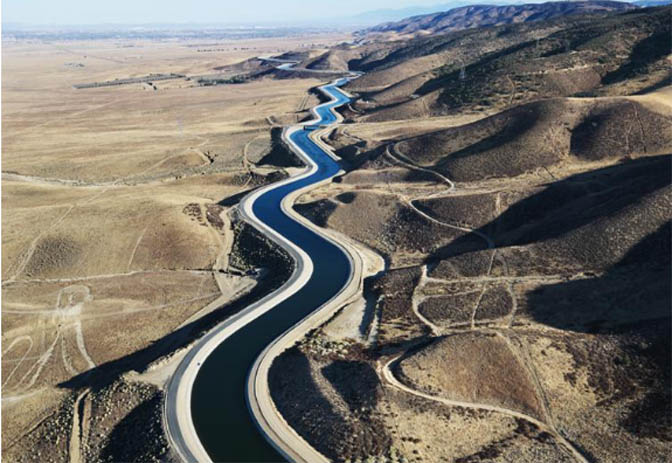
So what will happen to Arizona’s agricultural economy? I’m always taken aback when critics complain, “But they’re using all that water for FOOD!” I have no doubt that in the past, water waste by the ag industry, big and small, has been a problem. And new more efficient methods are being developed within the industry, not out of some sense of moral responsibility, but because finding more efficient means to grow their crops is the only way they’ll stay in business.
But it’s no different than cities, where its political leaders are trying to impose more stringent conservation methods. They’re not trying to save water, so that more than a trickle reaches the Gulf of California….
They’re trying to save water so their cities can keep GROWING. There’s nothing admirable about their actions.
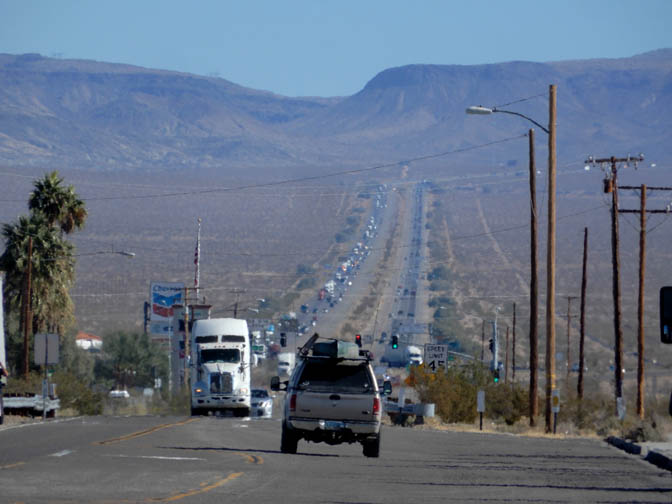
BUT MAYBE…GLEN CANYON COMES BACK.
Despite the overwhelming gloom and doom of this rant, it’s also true that Glen Canyon, buried by the waters of the Powell Reservoir, will most likely reappear in some fashion, in the next half century. Some of us have been waiting for that day to come…some since the day the river stopped flowing. The side canyons in Glen Canyon may restore themselves in a matter of decades or years. It’s already happening, thanks to the reservoir’s record low levels. And eventually it will continue to fall. I’m not as optimistic about the main channel of the Colorado River. It’s been a garbage dump for 60 years. And when the river flows again, it won’t be “The Place No One Knew.” In today’s insane recreational economy, waiting lists for permits will be in years, not months. Still, sooner or later it will come back.
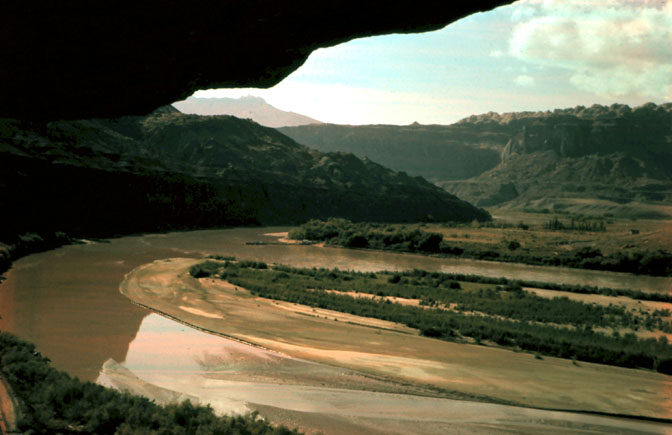
The writing is not only on the wall now; it was on the wall when they built it. They knew that these dams on the siltiest river in North America would eventually fill with sediment. And they knew that economic growth in the America Southwest would outpace previous estimates. They knew before the diversion gates were closed in 1963. They knew that river flow projections were based on an arbitrary and absurd estimate, from 1922, when the river flow was based on its heaviest annual flow in recorded history.
They knew all that.
Now as my generation winds down and younger Americans take charge of the country’s future, its resources, its people, and its soul, what will they do?
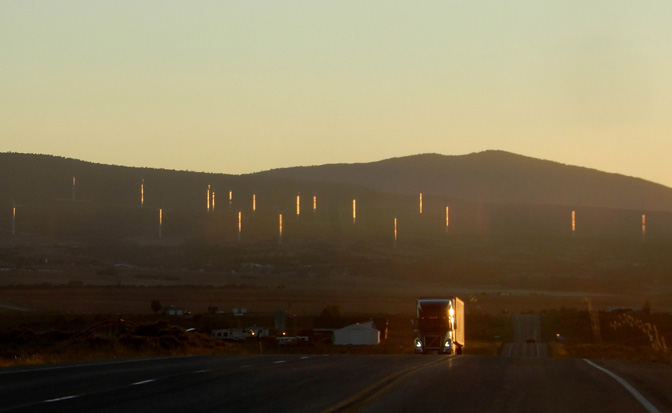
*****
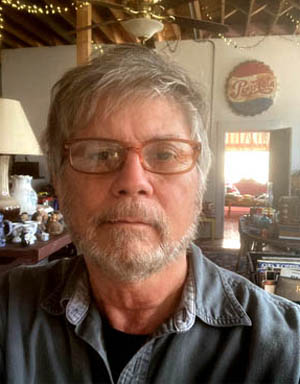
Jim Stiles is the publisher and editor of The Zephyr. Still “hopelessly clinging to the past since 1989.” Though he spent 40 years living in the canyon country of southeast Utah, Stiles now resides with two cats, Rambo & Rascal, on the Great Plains. Coldwater, Kansas is a tiny farm and ranch community, where there are no tourists.
He can be reached via facebook. Messenger, or by email: cczephyr@gmail.com
TO COMMENT ON THIS STORY OR TO EXPRESS AN OPINION, PLEASE SCROLL TO THE BOTTOM OF THIS PAGE. THANKS…Jim Stiles


And I encourage you to “like” & “share” individual posts.
Why they can’t just leave the site alone is beyond me,
but that’s what Facebook likes to do.
ALSO NOTE: I post old photographs and stories from our 25 year old archives every day. Pictures from Herb Ringer, Edna Fridley, Charles Kreischer.. even a few old photos from my Dad. So if you want to stay caught up on our historic photo collections,
be sure to “follow” us on Facebook…Thanks…Jim
https://www.facebook.com/FansoftheCanyonCountryZephyr/
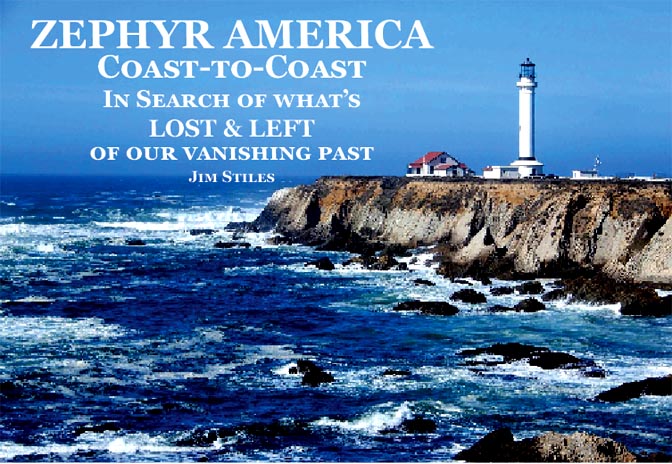
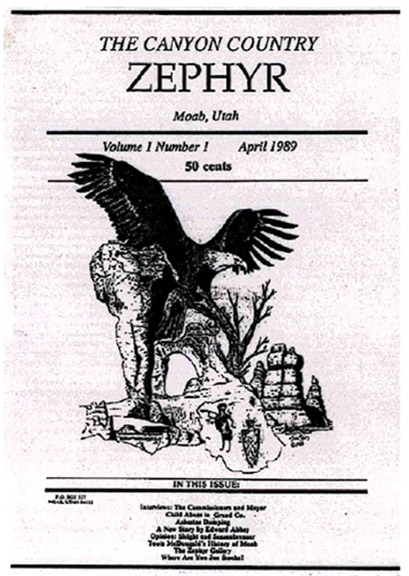
$55 Each or Two for $100 (Free Shipping.)
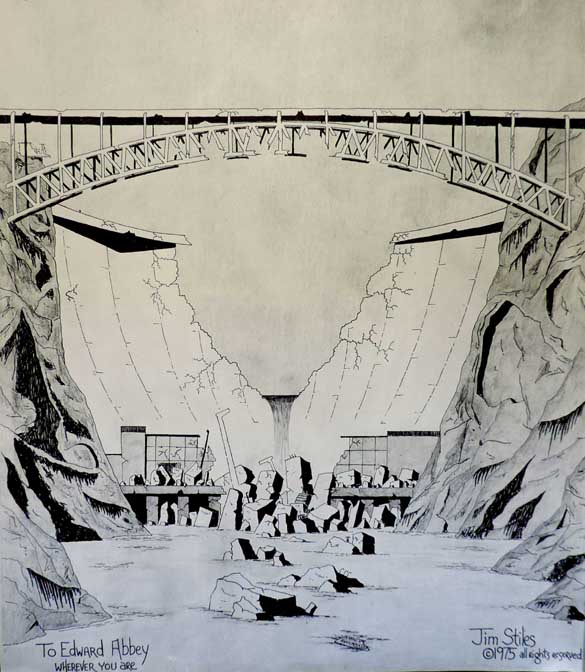
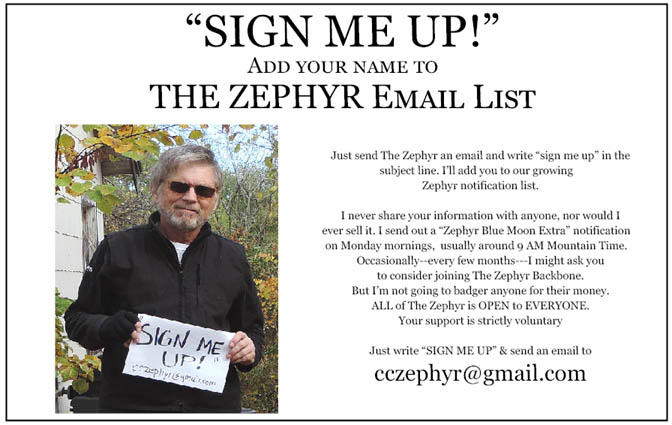
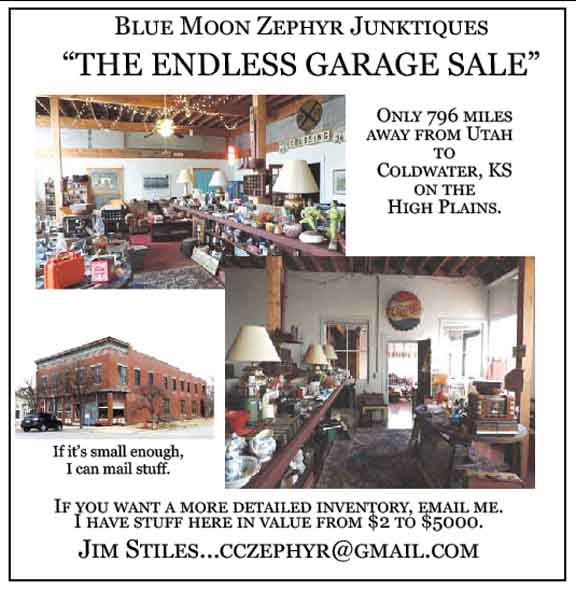
https://www.facebook.com/profile.php?id=100086441524150

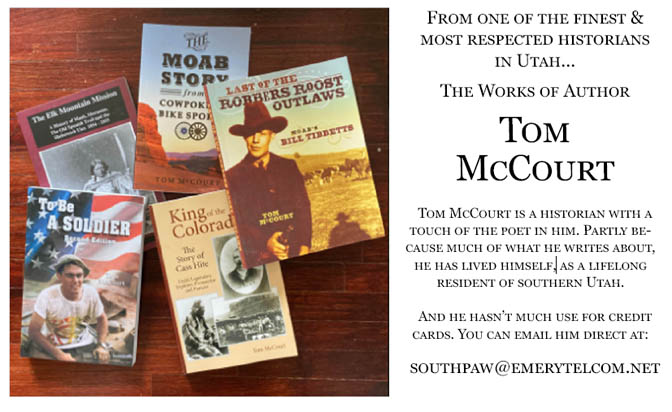

More than six years ago, The Zephyr, me & four other individuals were sued for defamation by the former Moab City Manager. Faced with mounting legal bills, my dear friends John and Isabel De Puy donated one of John’s paintings to be auctioned.
ALL the proceeds went to our defense.
Thanks to them, our bills were almost completely covered.
Now I’d like to return the favor. Check out the link below and their online shop… JS
https://www.depuygallery.com/

And check out this post about Mazza & our friend Ali Sabbah,
and the greatest of culinary honors:
https://www.saltlakemagazine.com/mazza-salt-lake-city/

https://www.canyoncountryzephyr.com/
REMEMBER! I’D LIKE TO HEAR FROM ZEPHYR READERS. TO COMMENT ON THIS STORY, PLEASE SCROLL TO THE VERY BOTTOM OF THIS PAGE.


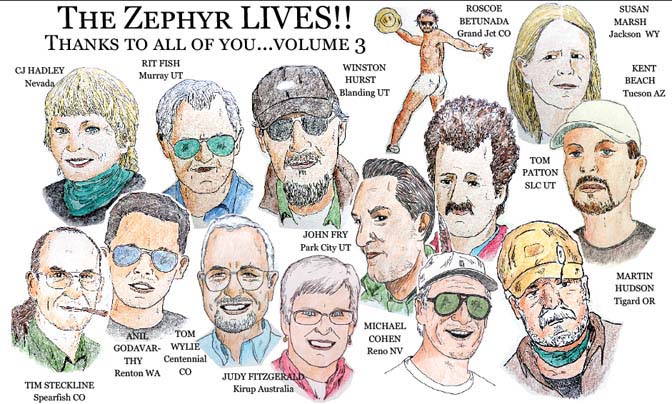
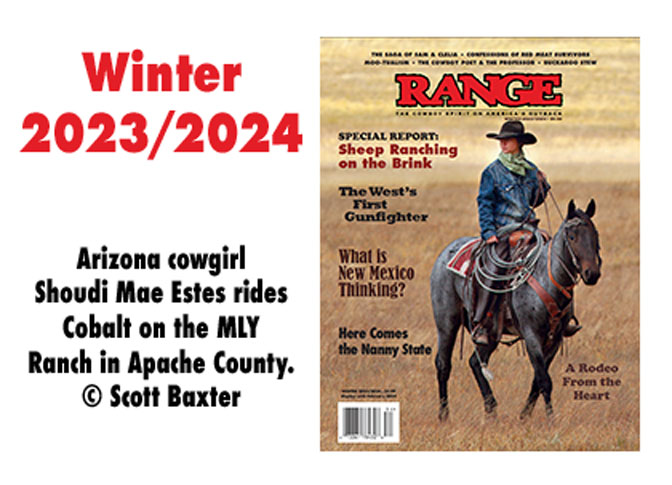
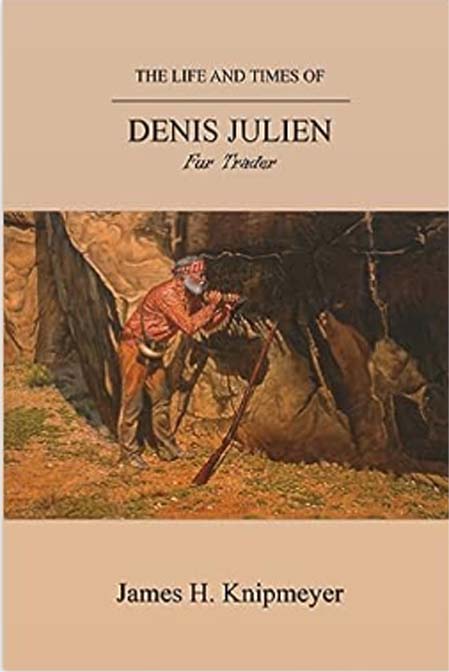

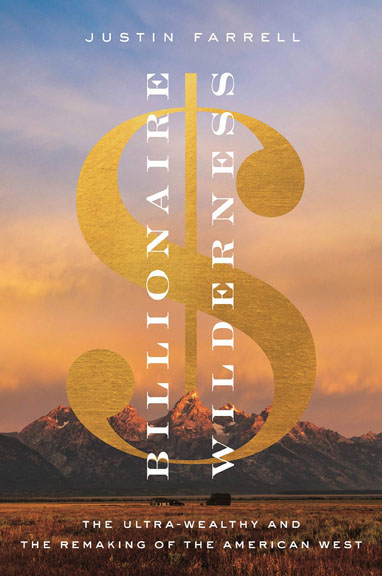

What an incrediblely well writen history from when I was 6 years old in the 50s on my first trip to the Sandstone country and coninue now all these 68 some years. and it was eventually the time I first discovered the Zephyr and you.
You continue to remind me what is important whether it is in the Sandstone Country or my home in Lone Pine and the Owens Valley.
I so much value our knowing each other and how much your words and ideas keep me alive, moving and speaking up in my own ways….Clark Trowell. and in the words of my portait you drew,Superman.
Can you turn this into some type of pamphlet to purchase so I don’t have to try and print all 48 colored pages on my old printer?
A lot packed into that one Jim. A pretty good case for a need of something besides a consumer/capitalism culture. Around the time I introduced myself to canyon country I read John McPhee’s Encounters With The Archdruid, about Brower. In it is an extensive section about Brower’s conversations with Floyd Dominy, the dam man, the self-proclaimed “nation’s waterboy.” Dominy believed it would take thousands of years to silt up, Brower predicted 1-2 hundred at most. Brower said “My advice to suicides is if you’ve got to go, take Glen Canyon Dam with you.” Floyd responded “Read Desert Solitaire, the guy who wrote it is way ahead of you” introducing Brower to Ed’s work.
Worth a read for anyone who hasn’t.
For a John Potter cartoon on the topic –
https://mountainjournal.org/cartoonist-spoofs-attitude-of-develop-wild-west-before-it-is-gone
I just was able to save this into my computer. Plus I probably will try out my printer anyway.
thanks for listening to my rant….
Another well-written, and thought-provoking, article, Jim! I too have been wrestling with how the Southwest can continue to support more and more population, as the water on which people depend shrinks and shrinks. I heard a story on an Arizona TV station that the farm area in La Paz County has subsided something like EIGHTEEN FEET in the past several years due to so much ground water being pumped to water the farm fields there. And, to make things even scarier, when the overlying ground subsides into an area that was once an aquifer, it shrinks the capacity of the aquifer to store water, even if southeast-style rain dumps occurred in Arizona, because the cavities would fill quickly and the rest of the rain would run off. Even Santa Fe, where I live, has to deal with short water supplies; but most of its population is on the east side of the Continental Divide, so Colorado River water isn’t quite as critical. Still, we too have had a long-running drought, and even the water stores we have are depleting. And, another example of water diversion I heard, was the one about where St. George, Utah wants to build a huge pipeline to get more water from Lake Powell; and that would hasten the reservoir’s demise. What is the solution, then? No one knows. Every solution being presented has issues. Eventually it may come down to mass abandonment of the Southwest unless a lot more rain and snow start falling in the Colorado River watershed.
I’m sure you remember Edward Abbey’s novel “Good News.” For Ed, it was a post apocalyptic tale of the Southwest after they ran out of water and energy.
His futuristic tale takes place in 1998.
Somehow “they” always find a way to keep growing, but at someone else’s expense. That was the point here. Agriculture will be sacrificed for more lucrative growth. More condos.
If renewables really replace the current energy grid, it will alter the American landscape that makes the drowning of Glen Canyon look like small potatoes.
A view of the American Southwest in 20 years would be interesting. I hope Ridley Scott is wrong.
The Glen Canyon Dam is a vestige of a dying economic model. In the future, the least disruptive, efficient and affordable forms of energy will win out; I believe that nuclear is the future.
But those who have spent the years of their lives waiting for the West’s hydroelectric dams to crumble under entropy or sabotage, have misspent precious time trying to bring about what nature and time will naturally bring about–though perhaps not as quickly as they have wished.
Think about it: In 1876 the forms of energy, jobs and careers were completely different than those that supported families in 1776. In 1976, few jobs that existed in 1876 still remained, save for farming, ranching, the food industry, artisan crafts and the performing and fine arts. In 2076 everything will be different and the economic model then will consist of jobs, careers and industries that don’t exist today, save for farming, ranching, the food industry, artisan crafts, and the performing arts and fine arts.
Today we are seeing the “renewable” energy industry waning, due to its spreading unpopularity and decades of proof that wind and solar are expensive, unreliable, unscalable and present a blight to the environment. It, too, like Glen Canyon Dam will come to pass.
We little humans have powerful emotional reactions to things we find distasteful, like hydroelectric dams and Industrial Tourism, but no economy in the world has not evolved with lightning speed–in a geological sense–and dams, save for those which exist on a small scale to provide localized power to farms, homesteads and small industrial outfits, will soon be a thing of the past.
If only we knew… oh, wait…
“I wish to make it clear to you, there is not sufficient water to irrigate all the lands which could be irrigated, and only a small portion can be irrigated…. I tell you gentlemen, you are piling up a heritage of conflict!”
— John Wesley Powell, speaking at the Los Angeles International Irrigation Conference, 1893
Of all the people to name this abomination after.
And imagine, Powell said this at a time when he presumed nearly all the Colorado River water would go to agriculture. I doubt it ever occurred to him that huge metropolitan areas and overextended human populations would be competing with water for farming.
Didn’t occur to the authors of the Colorado River Compact, either. But water rights are just as good as actual water, right?
“In 1950, the American Southwest was a vast, near empty landscape.”
As we’ve come to learn, a landscape near empty of people is not a situation that needs to be changed. Back then such sentiments along with the “be fruitful and multiply” mindset led my Great Gen parents to have 7 of us Boomer kids. The landscape in a global sense will “fix” (i. e. empty itself) just like George Carlin said –
“…And, by the way, there’s nothing wrong with the planet in the first place. The planet is fine. The people are f*cked! Compared with the people, the planet is doin’ great. It’s been here over four billion years . . . The planet isn’t goin’ anywhere, folks. We are! We’re goin’ away. Pack your shit, we’re goin’ away. And we won’t leave much of a trace. Thank God for that. Nothing left. Maybe a little Styrofoam. The planet will be here, and we’ll be gone. Another failed mutation; another closed-end biological mistake.”
The words I almost never hear when it comes to electricity generation in the near future are “reduction” and “conservation.” Most predictions and plans assume huge (HUGE) increases in electrical usage the next 50 years. No plans for where the electricity will come from. But growth is presumed. Not much about how we can reduce our footprint. That is usually conceded, that growth is inevitable.
For a harrowing vision of what may happen to the Southwest in the coming century, check out Paolo Bacigalupi’s fiction The Water Knife. It begins from the premise that the US government loses all control over the Southwest, because of its continued long-term mismanagement of it, and so control is scrambled over by Mexican cartels, Chinese warlords, and Californian business mafias, and isolated water hoarders like “The Queen of the Colorado,” who maintains control over stretches of the river and its waters with force and high tech. A “water knife” is a mercenary who kills people to protect or extend the water supply of one of these competing parties. The future does not look promising in this scenario, but it does seem plausible.
Exactly. Wendell Berry’s “production v consumption” says it all. I started to delve more deeply into that topic but it deserves a post of its own.
I raised this topic over a decade ago though here. The resistance was stunning. A group as radical as Deep Green Resistance worried publicly that public demands to conserve might alienate the public! Like… what else is there?
Anyway more soon on this topic.
But, that also include “huge increases” because the next 50 years (unless we wake up soon) will also INCLUDE THE ADDITION OF ROUGHLY 125 MILLION MORE PEOPLE IN THE U.S. (Duh!)
Remember Amory Lovins? He has been preaching reduction and conservation since the ’70s. We can engineer new construction and retrofit old construction to use a fraction of the energy and water used currently. PR firms, Ad agencies, and corporate journalism have sold us a bill of goods. We can do better.
https://writersontherange.org/energy-guru-says-energy-gap-can-be-bridged/
It is sad to read the dismal predictions of this article. Even sadder that alternative options while explored still do not seem viable. Yet I can think of no argument to counter these claims other than hope that the the Earth itself can naturally balance itself and once again deliver the winter snow needed to refill those lakes that are desperately needed by the populations. Once again we are subjugated by the forces of nature.
I do remember the 1950s, the 1960s, the 1970s–when Earth Day founder Gaylord Nelson and the Rockefeller Commission (made up of experts from business, economics, education, medicine and the environment) all called U.S. POPULATION GROWTH a problem for the U.S. and for the world. As the decades progressed and I built my own legacy as one of Ed Abbey’s “dam fighters,” helping to stop the massive Two Forks project on the South Platte, so sought after by Denver as water ran wasted down gutters, and helping to force the downsizing of the ghastly water-diversion project at Durango, Colorado, the Animas-La Plata, where water had to, first, be pumped UPHILL for thousands of feet–I followed closely the Clinton Council on Sustainability on their warning that “sustainability” is a MYTH without stopping population growth.
Now, in an era when MEDIA DEREGULATION means, substantively, all major media are owned by just 6 mega-corporations–Disney, Sony, Comcast, National Amusements, News Corp, Time-Warner–with them now (for the first time since 1932) perfectly free to put out only what they want and only in the content they want–I watch as we have become a nation that has forgotten POPULATION or the warnings of earlier times that we should never risk becoming 300 million people.
Yet, as corporate media lie and tell us we aren’t growing because of our declining birthrate (which will, nonetheless fuel growth for another 70 years or so) we are one of the fastest growing nations on Earth. Thus, any belief that growth in the Southwest is from a “western migration” is outdated and mostly wrong. (How about the “eastern migration” from California, through the 1990s and up to 2008, consider THE FASTEST GROWING “NATION” ON EARTH, and with fed up citizens moving north to raise ire in Washington and Oregon and east, toward, Colorado, where there was anger about the resulting “migration.”
Now, let’s look at some pesky facts. When Sen. Nelson founded the first Earth Day, SOLELY TO PUT FOCUS ON U.S. POPULATION GROWTH AS HARMFUL TO THE WORLD, we were about 200 million people, though even then, the 3rd MOST POPULATED NATION BEHIND ONLY CHINA AND INDIA. That’s about when the Rockefeller Commission–with focus, then, on births–put out the warning we should never “risk” becoming 300 million. But then, the birth rate fell, so a real hope for U.S. population stabilization.
But then, I submit because “corporate,” including soon, “corporate media” deregulated and free to put out whatever version of the “facts” it wants, became concerned that a fixed birthrate would drive up labor costs and cut into their “grow at any costs” core value. (If any of us want to consider that a value.”)
In response to that CORPORATE/ONE PERCENT concern, Lyndon Johnson gave them a new immigration act, deftly disguised to please liberals under the guise of being more equitable and inclusive of the world’s masses. Bull! It was about giving the U.S. a hefty new boost in population, to keep labor cheap/consumption high, as forces like the Sierra Club (which had in the 1980s published a bumper sticker, “The U.S.: The world’s most overpopulated nation.”) happily accepting at $240 MILLION DONATION in exchange for silence on the subject of population, pronounced concerns about immigration as racist, and liberal, tolerant body that it was, then put a gag-order on all local chapters not to debate the Club’s position.
But let’s get to the brass tacks. On the first Earth Day, we were roughly 200 million people. In October 2006 (as covered by the Canyon Country Zepher), we became 300 million, the hallmark earlier Americans thought would be dreadful–that as media largely ignored the event. But more stunning, today, less than 25 years later, we (U.N. data, since they’re more honest than the U.S. Census Bureau), we approach 350 million, including Biden’s FOUR MILLION A YEAR IN THE TSUNAMI STREAMING ACROSS OUR SOUTHERN BORDER.
As one who writes on water issues, I might also point out that U.S. Bureau of Reclamation internal documents have discussed that when Glen Canyon was built, the Bureau thought it would provide enough water for generations into the future. But the later internal documents admitted that such projections never fathomed the U.S. population growth–gratis of a lying news media, CORRUPT ENVIRONMENTAL GROUPS, and unfettered immigration–since about 1980. Of note, immigration–most of it ILLEGAL–currently fuels 93 percent of an EXPLODING U.S. POPULATION!
Headline: Though it’s hard to find, because “independent’ sources, like Google, insist on reporting growth based only on births, the U.S. is either the 5th fastest growing nation or the 6th, depending on whose numbers you look at–if you can find numbers. That, not long after (though absolutely UNREPORTED BY CORPORATE MEDIA) 18,000 CLIMATE SCIENTISTS said that population growth, ESPECIALLY IN THE HIGH-CARBON NATIONS, would hinder progress on fighting climate change, AND NEEDED TO BE ADDRESSED, especially in “China, the United States, and India” in that order, with that based on the order of per-capita emissions.
Perhaps it’s all time for us to all get back to the thinking of the 1960s and 1970s when THINKING AMERICANS–informed by a free, competitive, honest press who didn’t label people as “racists” for their concerns about population–to understand that national policies, NOT western migrations, are responsible for the now nearly 40 MILLION PEOPLE in the American Southwest, with cities–Phoenix, Salt Lake, Tucson–facing grim water futures under limitations of the Colorado River Compact and probably nothing more than drier NORMS, are also the FASTEST GROWING CITIES IN OUR’S THE 6TH FASTEST GROWING IN THE NATION IN THE WORLD! That’s pure lunacy! But then, so too, is a Constitutional Republic no longer regulating its electronic media to require that they not lie, impose news blackouts and work to create only a corporate version of “reality” for the U.S.!
Did you just write that???
“But then, so too, is a Constitutional Republic no longer regulating its electronic media to require that they not lie, impose news blackouts and work to create only a corporate version of “reality” for the U.S.!”
You WANT the federal government to unilaterally determine what is a lie and what’s not? By “regulating” them? How does that work? Which government would you like to give that power to? And what if the government in power shifts, from one you approve to one you don’t???
The Boomer generation failed the future, long before social media took over. They failed their own children when THEY turned over the education of their children to a poor education system and a media that was no where near the Tic Toc generation we see now.
I watched it happen in my own family more than 30 years ago. But now those “kids” are pushing 40 ad are utterly clueless. But that’s as a result of their upbringing, not a consequences of the last ten years.
But the bottom line for you is to “regulate” all information, by the government, is a very slippery slope. And one you might want to re-think.
All the above comments have presented my thoughts in an excellent manner! I informed a local political hopeful that I would be supportive if in fact the absolute number of building permits would be curtailed. Those of us who have lived in a DESERT have always been careful with both water and electricity useage. But still the expansion or hotels and housing continues. WE HAVE A WATER SHORTAGE!!
I think Ridley Scott and Paolo Bacigalupi’s speculative visions for the future might just be a little more optimistic than anybody gives them credit for. Doomsaying, yes; but I imagine that it’ll be worse than they think. Will readers of the Z be alive to see this catastrophic future? Keep yer radios dialed in to the Zephyr to find out!
The frenzied race to build dams. The frenzied race to build mega cities and their suburbs. The frenzied race to build renewable sources of energy. Lots of frenzied activity. To what end? So that northerners tired of winters could move to this artificial sun drenched paradise? So that tourists could take up residence and blight the place they admired from afar? So that farmland could be converted into condos and cookie cutter homes?
When all the farms are gone, who will grow the food? When the water is depleted how will people water their idiot lawns? The problem with cities, as Derrick Jensen has noted, is that they vacuum up resources and produce only trash. What happens when the resources dry up?
The builders of these dams knew about silt. They believed that the desert could be tamed; that they could transform a vast desert into an oasis. That the snow pack of the Rockies was eternal. What they didn’t couldn’t have foreseen was global warming and perpetual drought. Arid conditions could be ‘mitigated’, but can the effects of climactic change?
Abbey knew what the New West was which is why he railed against it in “The Monkey Wrench Gang”. But he was pissing up a rope. There was no stopping this frenzied juggernaut of development and expansion.
When I first camped in Arches in October, 1986 there were less than half a dozen other campers. One day on his rounds, the ranger invited me up to the trailer for a beer with some friends up from Moab. I camped in Canyonlands for 3 weeks that month and there were 2 other campers. When I finally was able to return in 2015 I was just appalled. In the intervening years a profound change had come upon not just Moab and its environs, but the parks themselves. Cryptogamic soil trampled, litter, hoards of sightseers, Jeep Week and all the rest.
As you rightly point out, there is no easy fix to the energy and water needs of an ever growing population. And with Utah’s nationwide promotion of “The Mighty Five” and social media broadcasting the location of hitherto unknown spots, the stories of human depredation fill one with disgust. Oh well…as Kurt Vonnegut wrote, “So it goes.”
Carl Sagan’s “Pale Blue Dot” sermon(consider the lilies and the birds) on the mount. Wendell Berry’s prophetic, ” the Objective” poem; Werner Herzog’s,”Where the Green Ants Dream”. Hospice the insane and insatiable, metastatic spread and short sighted hubris of mechanical economic time(death). Resurrect and Restore the humility and sanity of the ancient one’s Dreaming Ecologic time(Life). Locusts and Wild Honey(Mormon crickets and Camas root) till then….”may you live in interesting times.”
Nuclear is your only clean reliable power option. Natural gas should be the fall back. Wind and solar are not consistently reliable and the ROI has certainly not been where it should be to justify the expenditure. The build costs both financial (money) and environmental ( damage to the environment claiming materials) is astronomical. As I travel back and forth from N.C. to the four corners area every year, I see the piles of used wind gen blades stacked higher and higher. There doesn’t appear to be an economical and evo friendly way to recycle them. I see more and more units idled. Bottom line, political and financial elites got what they wanted. I made a conscious decision in 2019 to be done with Moab. Too many people, too many side by sides, outrageous costs and too many other more palatable options. I’ve followed you for years, but honestly the residents, the ones that could have made a difference, chose growth and greed. Not saying thats good or bad, just the route they chose and these are the results of their choice.
To fully understand what the silt has done to Glen Canyon. Go to the second to last picture in this article, the one titled “Glen Canyon at Hite, by Edna Fridley.” When that photo was taken, Edna was sitting in a small alcove just below the old Indian fort called Fort Moki. I was there many times as a child. In her photo, the Hite ferry can be seen on the right side of the river just before the bend in the river, and you can see the road from the ferry landing to the town of White Canyon in the left bottom corner of the photograph, way below where she is sitting. Today, the silt in that valley has covered the alcove Edna was sitting in when she took that picture. Imagine that, if you can.
Thanks Jim great writing. The situation seems overwhelming and few people seem to know or care. We won’t be here to see it play out but it’s still depressing.
” Everything is going to become unimaginably worse and never get better again. If i lied to you about that, you would sense that I’d lied to you, and that would be another cause for gloom.” Kurt Vonnegut, Jr.
Massive climate migration is now destabilizing governments in the world temperate regions, and will not stop. It’s nothing new. Humans have been doing it since there were…humans. When the water stops, people move, but to where? There. If there is no water there, then where? “Curiouser and curiouser” Lewis Carrol. Cheers from the Billionaire Wilderness
Wellll,after living in the southwest for almost 55 years,it just seems to me we are living in the age of absurdity. Everything and all of it.absurdity is a very powerful subject.i tend to think it’s more of a cosmic event rather than human…
Jim, this is the best, most impactful article of yours I’ve yet read, considering that they are all impactful; the plethora of comments bear that out.
Yes, we who were fortunate to taste the Southwest in the mid to late 1900s have our memories, photos, and lamentations on what was and will never again be. As you suggest in your article, that is true almost everywhere in this country.
I might add (and this has been hinted in the article and many of the comments) that these changes are global, including of course an expanding human population showing no sign of voluntarily ceasing its growth. We can look at the conversion of farms and orchards to expensive housing developments as a local impact that changes the character of a place we loved, creating the Moabs, Phoenixes,, Tucsons, etc. we see today. So far, at least we readers still find the food and water we require in almost any place we look. But I do not look forward to the day when I or my descendents will witness and struggle with, due to catastrophic drought or other calamity, the complete large scale collapse of of our production and distribution of resources that actually sustains life.
As one of the other comments above states, the Earth itself will continue to spin and revolve, with or without us.
Somehow I spent most of my morning reading and thinking about Jim’s article. I am in my 90th year and have lived through the history that this article so well explains in an honest foresighted way that is so seldom seen. I agree with those who feel that nuclear is the best energy bridge between fossil fuels and the ultimate source of energy, fusion. However, the water situation seems even more difficult to solve. A friend’s bumper sticker, “no farms, no food” expresses well what seems to be poorly understood by the public. I have heard this, “we don’t need these apple orchards, we can just go to the store and buy apples”.
I fear that as the value of a square foot of land in the Southwest becomes absurdly overpriced and overvalued, agriculture will die and we’ll get our fruits and veggies from other countries. Imagine it getting to the point that it’s cheaper to import our food. Not because we can’t readily supply most of our needs, but because the demand for land to develop for residential and commercial development becomes too lucrative to ignore. Neither small farms or Big Ag can ignore bottom lines. And especially for independent small farmers, with a new generation reluctant to work dawn to dusk, it’s hard to pass up a deal like that.
A real reckoning is coming, but I’d bet not nearly as soon as some think. Or even hope.
Jim, I came through Chelan WA on the way home from a few days at winter play camp. Seeing some condos on the hill, I sang the chorus of Little Boxes.
Splendid article; I’ve forwarded it to many friends. One thought: many of the same “progressives” who prattle on about “ecology” and “sustainability” are the same ones who. on the other sides of their mouths, support more or less “open borders”. Are they REALLY that stupid? …. Robinson Jeffers, America’s greatest poet, foresaw the future nearly a hundred years ago………..”But all seasons
The earth, in her childlike prophetic sleep,
Keeps dreaming of the bath of a storm that prepares up the long coast
Of the future to scour more than her sea-lines;
The cities gone down, the people fewer and the hawks more numerous;
The rivers mouth to source pure; when the two-footed
Mammal, being someways one of the nobler animals, regains
The dignity of room, the value of rareness.
(November Surf)